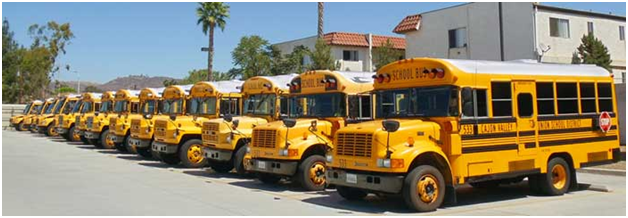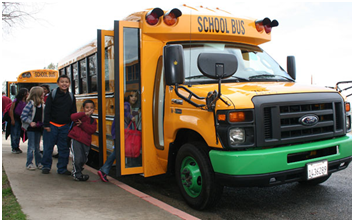The yellow school bus is an American icon. There are over 450 000 of them. Overall they are robust, reliable and safe.

However, they are anything but clean. Almost all school buses use diesel engines. The exhaust contains particulate matters, carbon monoxide, nitrogen oxides, volatile organic compounds (VOC). Studies have shown that children in buses are exposed to unhealthy levels of these emissions. While breathing diesel exhaust is not healthy for anybody, it is more serious for children, since their respiratory systems are still developing.
The exhaust problem is well known and several actions have been taken to mitigate the problem, e g by reducing idling time, changing drive patterns, installing filters, etc. New diesel engines are much cleaner than the old ones, but harmful emissions issues remain.
The ultimate, some would say “no-brainer”, solution would be to make school buses plug-in electric (PEV). It would eliminate the exhaust emission issue once and for all. The technology is available and is being demonstrated in pilot projects like the one in Kings Canyon Unified School District in California. The program started in March this year and will be expanded to four PEV school buses. The school district expects to save $10 000+ per year in just fuel and maintenance costs.

Trans Tech Bus electric school bus for Kings Canyon Unified School District. The bus uses a Ford E450 chassis. Motiv Power Systems provides the electric power train.
So why do we not have more of PEV school buses? Why is it not happening? The reasons have been performance and cost. The performance issues have been limited operating range, insufficient power, inadequate reliability etc. However, major technical progresses, including applying solutions from other plug-in electric vehicles, have largely eliminated the performance issues. In a recent completed project, Economical Electric School Bus (EESB) project, implemented by TransPower with funding from California Air Resource Board (CARB) an electric school bus with an advanced electric drive train demonstrated excellent performance including one month of service with Escondido Union High School District. (Economical Electrical School Bus EESB Final Project Report June 2nd 2014.)
The cost issue is the biggest challenge. School districts have limited funds and have rarely any other option than going for the lowest first cost when buying new buses. The present school bus design offers the lowest first cost. A new diesel powered school bus costs $110 – 180 000 (depending on type, size and equipment). Corresponding PEV buses cost $230 – 440 000. A charging station can add several thousands of dollars unless the charger is integrated in the electric power train. Evenwith fuel and maintenance savings for the electric school bus the total cost of ownership (TCO) during the estimated 14 years of life tends to come lower for the diesel powered school bus.
However, PEV school buses have unique features that can be monetized. When connected to the electric grid they can provide a power source for the grid. The Vehicle to Grid (V2G) concept has been demonstrated in PJM Interconnect. A fleet of 15 BMW Minis participated during 2013 in PJM’s Regulation Market, a reserve product to balance supply and demand on a second-by-second basis.

BMW Minis at University of Delaware participating in PJM’s ancillary service markets.
Fleet vehicles in general and school buses in particular, are by far the vehicles best suited for V2G applications. School buses have defined routes of limited range and very predictable time of use. During school days they bring the school children to school in the morning and back home in the afternoon. The other 17 hours of the day they can be plugged in, provide V2G services and collect the revenue for it.
Lance Noel and Regina McCormack at University of Delaware, which is a research and demonstrations leader in V2G, has done a detailed analysis, “A cost benefit analysis of a V2G-capable electric school bus compared to a traditional diesel school bus”, compares a Smith Newton electric school bus equipped with a 70 kWh battery to a Type C diesel school bus. The study uses data from PJM’s ancillary service markets and typical routes and schedules for the school buses. The conclusion is that a PEV school bus with the V2G benefits will have a lower TCO than a traditional diesel powered school bus. The difference is significant, $218 000, which does not include the value of lower emissions!
The analysis shows that the annual fuel cost for the diesel bus is $6350. For the PEV school bus the “fuel cost”, i e the electricity, will be $714. Nevertheless, the V2G benefits, which were calculated to be $15 274 per year for the regulation services, is the potential “game changer”.
Trying to quantify the emission externalities the analysis also takes into account the emissions from the power plants generating the electricity to charge the PEV school bus. Even so, the electric school bus emits (indirectly) only 1/6 of the emissions of the diesel bus. For the school children the real difference is much bigger, since they are in and at the source, the diesel school bus.
For the carbon (CO2) emissions the difference between the two types of buses is significant. According to the analysis the diesel bus emits 22.2 lbs. of carbon per kWh. The electric bus emits (indirectly) 1.18 lbs./kWh. Using the National Research Council’s estimate of the average social cost for carbon, $36 per metric ton, it adds up.

TransPower electric school bus as tested by Escondido Union High School District. The bus uses a Thomas Built Saf-T-Liner HDX school bus. TransPower provides the electric power train.
With the much lower TCO, assuming the V2G benefits, and the additional benefits of lower emissions the rational decision would be to buy PEV school buses instead of continuing to buy traditional diesel school buses. Nevertheless, the first cost of the diesel bus will remain substantially lower than the electric bus. Realistically, it will be a major barrier for the PEV bus.
Over time the gap in first cost will be reduced thanks to increased production volumes and resulting economy of scale. However, due to the cost of the battery the electric bus will always cost more. A rough estimate is that for a full size school bus the cost delta could eventually be reduced down to $100 000, give or take.
In spite of the $218 000 savings in TCO even the $100 000 in the higher first cost may still be a hurdle for the school districts to overcome. One possibility to bridge the first cost delta would be in markets like PJM to have a third party contribute (basically invest in the battery) in return for a revenue stream from the V2G services. In non-electric markets it could be the vertically integrated electric utility to do the same.
In States like California PEV school buses may also get carbon credits the same way as Tesla, who has been able to monetize the carbon credits up to about $35 000 per car! Since the purpose of the California carbon credits is to reduce carbon emissions, one could argue for awarding more credits to an electric school bus than to an electric passenger car.The electric bus replaces a diesel bus, while an electric passenger car replaces an already rather fuel efficient passenger car.
In summary, technology progresses, more awareness of emissions, the opportunity of V2G and the possibility of carbon credits will make electric school buses increasingly attractive and hopefully the “no-brainer” choice.